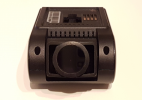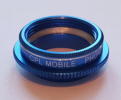My final (?) DIY solution, before the Viofo CPL I ordered today arrives, is much simpler than the magnet versions, and costs £1.79 (if I make ten!)...
Parts:
Ten 19 x 14.1 x 1.5mm self adhesive fibre washer = £1.79 = £0.18 per unit
https://www.ebay.co.uk/itm/251120376539
One 15.1mm crystal watch glass = £1.50 (various diameters, including 14.1mm, but I prefer a slight stretch to the washer, above).
https://www.ebay.co.uk/itm/290957718709
One Samsung S6 CPL film (will make 15 filters) = £1.59 = £0.11 per unit
https://www.ebay.co.uk/itm/191983059127
Total cost per unit = £1.79
Overall cost to make one unit only = £4.88
At 1.5mm thick and 14.1mm internal diameter for the washer there is no vignetting, i.e. the inner edges do not show in the video clips.
A slightly oversize square of self-adhesive CPL film is stuck to the watch glass (outside edge), air bubbles easily removed, then trimmed to the glass edge.
This filter is pushed into the washer so the outer edges of each are flush. A few tiny drops of super glue on a needle are applied to the inner bevelled glass edge where they are sucked into the join with the fibre washer by capillary action.
The washer's adhesive protection paper is removed at the rear, as is the CPL film's at the front, and it's stuck lightly to the A119, centred on the lens housing.
Any final adjustment to rotation can be made by removing and repositioning the washer several times before pressing firmly in its final position.
The A119 lens is fully enclosed and protected from dust (cleaned before application of filter) and the CPL film can be cleaned with a micro fibre cloth without appearing to scratch easily.
Here's one I made earlier, using the 16mm glass element from the cheap mobile phone filter (the watch glass above is better optically, but not here yet).
Washer's a bit battered as the ones I happened to have are a few years old!...

If I could find 3M double sided rings 16x20mm in diameter I'd just stick the CPL film to a 20mm watch glass and stick this to the lens housing with the 3M ring. But I can't.
It's been fun, but I'm fairly sure the proper Viofo CPL will see all my experiments consigned to a drawer in a week or so. EDIT: Cancelled Viofo order due to issues raised 30th Nov. See CPL thread. Back to DIY!










